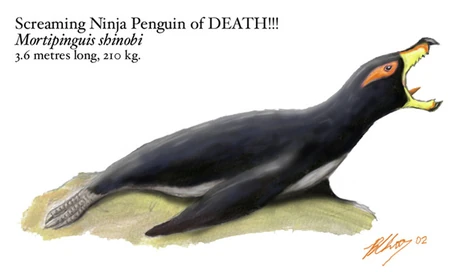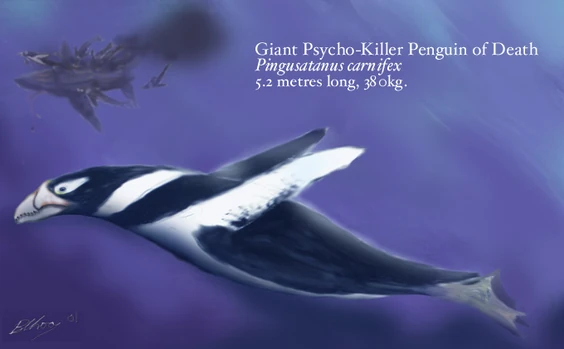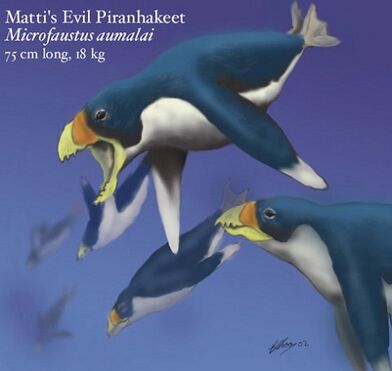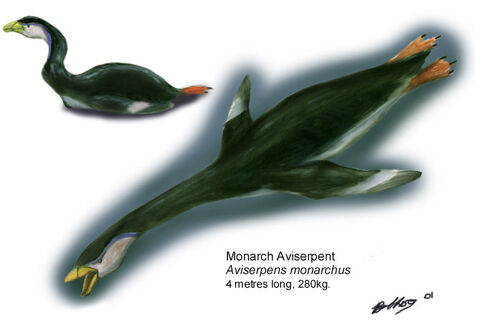Penguins ply the southern seas of this timeline and ours and are known as Paleocene fossils from both worlds. This would suggest that the sphenisciformes had already appeared by the end of the Cretaceous or that presence/absence of the K-T event had little impact on the evolution of penguins, probably on small islands in the New Zealand archipelago. Penguins have, thus, evolved along more or less the same lines in both worlds. However, in addition to familiar penguins, Spec's Sphenisciformes include a far greater variety of body forms, some of which include the largest of all avians.
p-SPHENISCIDAE ("Normal" penguins)[]
The diversity of Spec's penguins is slightly greater to that of Home-Earth. Several species inhabit estuarine or even freshwater habitats. Unlike our penguins, some species still retain procellariform-like tube nostrils.
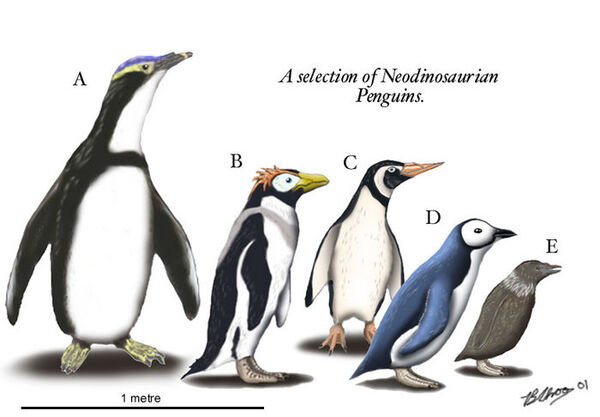
Representatives of p-Spheniscidae: (A) Padishah penguin, (B) Silverband hawkfinch penguin, (C) Greater swordbill penguin, (D) Blueback penguin, (E) Brown penguin
Padishah Penguin (Gigapinguis coronatus)[]
The largest Spec spheniscid breeds around the Antarctic coasts on the sea ice in a manner akin to our emperor penguin. If feeds largely on krill and small fish.
Silverband Hawfinch Penguin (Baryrhynchos reiayanamii)[]
The Spec seas have a far greater variety of hard-shelled pelagic molluscs than do ours and the evolution of the hawfinch penguin is the result of this. It has a solid, heavy beak that can exert a force of over 45kg to crush ammonoids and shelly argonauts.
Greater Swordbill Penguin (Xiphirhynchos ahlquisti)[]
The greater swordbill penguin is a primitive inshore/estuarine species from New Zealand. It uses its long bill to probe for buried worms and molluscs on the seafloor.
Blueback Penguin (p-Eudyptula paracaerulea)[]
For all practical purposes, this animal appears to be a slightly larger, differently colored variant of Home-Earth's little penguin (Eudyptula minor). Along with galagos, eucalyptus trees and cormorants, it represents a baffling case of extreme evolutionary parallelism between the two timelines (the p-(parallel) prefix is a new convention to differentiate Spec genera from identical Home-Earth forms).
Brown Penguin (Nanospheniscus novaezelandiae)[]
This tiny, drab-coloured penguin inhabits montane freshwaters of New Zealand where it feeds on small fish and insect larva. Little is known of its habits.
A PANOPLY OF PENGUIN DIVERSITY[]

A selection of Spec penguins, described clockwise from top: Gordon-pym, Antarctic sawnoff, Stripebill croffin, Barreled cobblepots, Streakbeak, Smasher, Tw'izur, Robber penguin, Spatengula, Lasagna penguin, Archer penguin, Gwyn, Ogremaw, Forceps-bird.
Gordon-pyms (Frigiornis vernepoei)[]
Gordon-pyms are common denizens of the Antarctic ice fields. Nesting in large groups, their eerie calls of "tekeli-li-li-li" are a regular and disconcerting feature of the glaciers and snowdrifts. The enlarged, hook-like lower bill of a gordon-pym is used for interspecies display and fights, in which the bills are locked together like fighting salmon.
Sawnoffs (Serratopinguis sp.)[]
The sawnoffs, which include the Antarctic sawnoff (Serratopinguis australis) and the sam-sawnoff (Serratopinguis lindsayi) are widespread primitive penguins. Found throughout the southern hemisphere, these feathered fur seals are generalist divers and fish-eaters. Serrations on the bill are a distinguishing feature of the type, and allow better grip on slippery fish. Sponges are also taken, including the sea pudding sponge (Saccharoporifera insolita) which is nibbled in small pieces by the penguins as a delicacy, always allowing it to grow back for later eating. Sawnoffs gather in enormous rookeries to mate and rear their chicks; any intruders are seen off with loud jabbering and "flipper-flapping" (smacking the offender soundly with the broad edge of a flipper).
Stripebill Croffin (Kronospheniscus pardorhynchus)[]
Stripebill croffins are among the largest "classical" penguins, and also among the least-known. These majestic loners lead a mysterious life cruising the open sea, meeting with others of their kind only during the mating season, which itself is a subdued, two-penguin affair. Croffins are known to be fast swimmers and deep divers, a conclusion reached after countless failed expeditions to thoroughly research them. Stomach-content analysis indicates them to be voracious predators, feeding upon anything small enough to be torn apart and swallowed.
Barred Cobblepots (Rotundytes kanei)[]
Barred cobblepots range as far north as New Zealand and Australia. These large penguins have few sea-based predators as they nest well inland; however, they are still exposed to predatory birds and mammals on the coast. When threatened, they raise the feathers around their head to form a sort of "frill" or "umbrella" to appear more intimidating.
Streakbeak (Bigarrhynchus minutus)[]
The little streakbeak fills the position of the Adelie penguin. Ranging widely over the shores of the Southern continent, these small penguins feed on fish and krill and are themselves prey to mortipinguids and other large predators. The brightly-colored and striped bill is for display, and also elicits beak-tapping from the penguin hatchlings (an important stimulus for food regurgitation).
Smasher (Destructorhynchus truncatus)[]
A massive, Gastornis-like beak is the bill of fare for the smasher, also known as the crab-eating seal-penguin or whalehead penguin. Armed with such a bill and mighty jaw muscles to go with it, smashers are equipped to deal with the toughest of shellfish. They will eat armored animals that most other predators would shun, and indifferently cracks the shells of crustaceans, bivalves, and any shellfish unfortunate enough to be in its way. Smashers have been known to crunch through thin layers of rock to get at the piddocks hidden inside. The bill can also double as a fine defensive weapon.
Tw'izur (Fistulornis aequorus)[]
Tw'izurs are delicate feeders, the gourmets of the penguin world. While not as specialized as forceps-birds, they can use their extended, slender bill to probe in the mud for worms, select the choicest limpets off rocks, and snatch fish from a baitball with ease. Colonies of tw'izurs can be found on Patagonia, associating with anatolutrids and waldos without competing for prey.
Robber Penguin (Mcgrawpinguis parki)[]
Robber penguins are small and otherwise typical penguins. Their main claim to fame is their irrepressible tendency to steal the eggs of neighboring penguins during the mating season. Pairs of robber penguins will charge into a penguin rookery and attempt to cause maximum chaos in minimum time, and steal as many eggs or chicks as possible. These "spoils" are taken off to feed their own chicks, or to toy idly with for hours. Sometimes robber penguins seem to steal for the sheer pleasure of stealing. They have been known to pinch bright and shiny objects from campsites, including one expensive diamond ring (the whereabouts of which is still unknown).
Spatengula (Clypeorhynchus obsoletus)[]
The spatengula is arguably the oddest penguin, with its flattened ducklike bill and spotted coat. Spatengulas are actually specialized bottom-feeders, using the broad tip of their beak to aid in exploring the benthic sand and ooze for prey. Once prey, be it crab, worm, octopus or shellfish is detected, the great spatula rapidly snatches it before the prey item can react. While spatengulas may appear comical in appearance as well as in sound (their loud "GURK!" does nothing for their reputation), they are excellent divers and stolid nest-defenders, even in the face of southern foulmars and mortipinguids.
Lasagna Penguin (Pastapinnis durophagus)[]
Lasagna penguins are likely to be close relatives of smashers. These heavy-billed, stout-bodied penguins ply the Straits of Magellan in search of mollusks and crustaceans, which are easily dispatched with the strong bill. The name is derived from the bright-yellow feathers dangling on either side of the head. Found in both sexes, they are important display structures.
Archer Penguin (Isurornis acer)[]
Archer penguins are nimble, agile-swimming penguins that make a living of pursuing large shoals of fish, bulletting into them and re-emerging with their beaks loaded. They are essentially precision hunters, occasionally gleaning worms and small animals from lower depths. Archers have been known to work in teams, with some penguins diverting the school of fish towards the other penguins.
Gwyn (Albacirra cryophila)[]
The gwyn is the southernmost species of Spec-penguin, breeding too far inland for the penguins of death and other predators to be a nuisance. Immaculate white feathers, coupled with a haunting, musical call, give gwyns an otherworldly beauty to them, especially during the dawn and evening choruses produced by rookeries. This said beauty is marred by their tendencies towards cannibalizing rival chicks and pecking nosy explorers with their deceptively sharp beaks.
Ogremaw (Ogrornis truncatus)[]
Ogremaws despite their basically durophagous adaptations, are quite satisfied eating anything edible. Ranging quite far north for a penguin, they have been known to heave themselves ashore to feed on seabird and turtle eggs. Out at sea, their heavy, spiked bills make short work of clams, krill, fish, young sharks, squid, and miscellaneous detritus. Despite the formidable beak, they are actually quite docile, placid, and slow-moving.
Forceps-Bird (Forficornis pictops)[]
The forceps-bird is the culmination of spheniscid worm-eaters. Its long, thin, delicate beak is dedicated to probing in the mud to unearth a banquet of worms and tunicates that would otherwise be hidden from other penguins. Forceps-birds cannot stand up to an attacker, but they make up for that with their breathtaking underwater speed. The long bill may also be an adaptation to fast-swimming, as with swordfish. During the mating season, males develop a spectacular, colorful array of striped face-feathers which serve in display and attracting mates.
MORTIPINGUIIDAE (Penguins of death)[]
The penguins of death are large, predatory sphenisciforms with powerful, serrated beaks that rampage across the Antarctic and Southern Temperate oceans. They tackle large carcasses in a manner similar to a crocodile's "death-roll", latching on with their beak and rotating their entire body.
Penguins of death are monogamous breeders. The female has a small marspuial-like pouch near her hindlimbs where the single egg is incubated. During this time, she has to lie on her side or back to avoid crushing the egg. The hatchling is initially nourished on secretions within the pouch before being fed on regurgitated food brought back by both parents.
Leering Baby-Eating Penguin of Death (Mortipinguis paedophagus)[]

Leering baby-eating penguin of death, Mortipinguis paedophagus (Patagonia)
The notch billed penguins of death (genus Mortipinguis) are inshore predators, rarely venturing far out to sea like their cousins Pingusatanas and Microfaustus. The solitary Baby-eater gets its name for its habit of lurking near juvenile crèches of other large penguin species, pouncing on an unsuspecting youngster and brutally tearing it to pieces. They apparently enjoy this activity so much that they will kill a chick, consume it, then promptly regurgitate and discard the body before seeking out another victim. Baby-eaters can be found around the Patagonian coast and the Falklands.
Screaming Ninja Penguin of Death (Mortipinguis shinobi)[]
The screaming ninja penguin of death is the scourge of the Aotearoan seas. Generally hunting as mated pairs, these screeching demons will tackle prey up to the size of an adult monarch aviserpent. They are resourceful animals and have also been seen scavenging and digging for mollusks. On rare occasions they will ambush and drag large terrestrial birds to their deaths at the shoreline.
Giant Psycho-Killer Penguin of Death (Pingusatanas carnifex)[]
The giant penguin of death (technically known as the giant psycho-killer penguin of DEATH!!!, or Pingusatanas carnifex) is the top predator in the frigid waters around Antarctica. It is the largest and most sounthernmost penguin of death species and the only member of its clade to breed on the Antarctic pack-ice.
Giant penguins of death roam the seas in marauding packs of up to a dozen individuals, taking a variety of prey, including fish, sharks, and smaller penguins. Occasionally, frenzied attacks are made against larger animals such as balaenateuths, although these are usually sick or injured individuals.
Matti's Evil Piranhakeet (Microfaustus aumalai)[]
The 3 species of piranhakeet are the smallest and most northern-dwelling of the penguins of death, found in temperate and subtropical waters in the Southern Hemisphere. At under one meter in length, these dumpy-looking birds are capable of awkward bipedal waddling on land but usually flop around on their bellies like their larger, polar cousins. Piranhakeets hunt for food far out to sea but come ashore on remote oceanic islands to breed.
Matti's evil piranhakeet has a distribution centered in the subtropical southwest Pacific with breeding colonies on Norfolk Island and the Kermadecs. For most of the year they prey on small pelagic schooling cephalopods and fish, foraging in small flocks. However, during the winter months, they gather in their thousands near the mating areas of Antarctic balaenateuths such as at the Kermadec Trench.
The annual breeding of the great cephalopods provides a banquet for these screeching little blighters. The act of mating (males furiously compete for females which they impregnate by inserting a sperm-package into their bodies via their exhaust nozzles) is extremely strenuous and results in many dead, crippled or just plain exhausted male baleen squids. This is the cue for the marauding piranhakeets which swarm around the stricken giants, gnawing off their flippers before boring into the mantle and eating their giant victims from the inside out. Even a crippled balaenateuth is usually capable of fighting off a large predator but they can do little against such a savage multitude.
During these feeding frenzies, piranhakeets become extremely undiscerning as to the target of the attacks and will go after saurocetes, boats, wounded comrades, even the moon! The piranhakeets have timed their breeding cycle to coincide with this bonanza and the mothers emerge out of the churning, ink-stained water with full crops of calamari for their hungry chicks.
AVISERPENTIDAE (Aviserpents)[]
The aviserpentids are medium-to-large sphenisciforms closely allied to the megapinguiids with elongated neck vertebrae. Most of this family are nearshore forms.
Monarch Aviserpent (Aviserpens monarchus)[]
The largest and most specialized of the aviserpents that feeds on shoaling cephalopods, particularly larval balaenateuths that often swarm around the New Zealand coast. It slowly cruises near the surface, snapping it's long neck from side to side as it seizes prey.
The nest of the monarch aviserpent is unique among the animals of Spec. Both parents construct a conical "fort" of small rocks up to 5 m across at the base and 1 m high. At the apex, a single egg is laid in a shallow depression lined with decaying seaweed. The parents take turns in sitting atop this structure to incubate the egg.
The monarch aviserpent's range is centered around New Zealand, with occasional specimens turning up in Tasmania, Lord Howe and Norfolk Island. Its distinctive serpentine silhouette is a common sight in the Cook Strait.
Red-Faced Aviserpent (Pelagocorax sibleyi)[]
Aside from its bright-red facial feathers, the red-faced avisperpent is a fairly typical representative of the family. It is found throughout New Zealand and Southern Australia where it feeds on a variety of schooling fish and cephalopods.
MEGAPINGUIIDAE (Teals)[]
The Megapinguiidae are large, generalized seal-like forms of the South Polar seas. As penguin body size and flipper musculature became more massive, bipedal waddling became impractical and most of the larger sphenisiforms (Megapinguiidae or "megapenguins") clumsily drag themselves on their bellies using their powerful flippers in the same manner as sea-turtles. This method of locomotion makes them extremely vulnerable on land, thus the megapenguins only breed in the most remote localities including oceanic islands and the Antarctic ice shelf.
Elephant Teal (Aviposeidon gargantuis)[]
The elephant teal is possibly the largest avian that has ever existed. It lives along the rocky coasts of Southern Oceanic islands and the Antarctic mainland. Its sternum is a huge, boat-like structure adapted to support its great bulk on land. Its bill is gooselike and is used to catch the small shoaling cephalopods which form the bulk of its diet.
The elephant teal mates on the Antarctic Ice. During the breeding season the males develop prominent facial wattles and begin extremely vocal mating displays. The call of the male sounds like that of a booming "Donald Duck tantrum" amplified to deafening levels that can be heard for many miles: "QUAAAA-QUA-QUA-QUA-QUA-QUAAAAAAAAAK!" Fights often break out over display sites, sometimes leading to serious injury or death - easy prey for giant penguins of death.
The smaller females flock towards the most attractive males. The actual coupling takes only a few seconds and the female then leaves with the male taking no further part in the raising of their offspring. The pregnant females migrate north, coming ashore in the Subantarctic Islands and Tierra del Fuego. The 2 eggs are incubated in a mound of rotting seaweed - this has the added effect of attracting swarms of insects and amphipods which provide the semi-precocial chick with food that is supplemented with squid brought back to the nest by the mother. The mother abandon the chicks at 6 weeks, but by then they are fully independent and form adolescent crèches. They stay in Sub-Antarctic waters until they are over a year old whereupon the survivors are strong enough to make the journey to Antarctica.
- Brian Choo
,=Gigapinguis coronatus (Padishah penguin)
,=Procellarhininae=|
| | ,=Xiphirhynchos ahlquisti (Greater swordbill penguin)
| `=|
| `=Nanospheniscus novaezelandiae (Brown penguin)
,=Spheniscidae=|
| | ,=p-Eudyptula paracaerulea (Blueback penguin)
| `=Eupinguiinae=|
| `=Baryrhynchos reiayanamii (Silverband hawfinch penguin)
=Sphenisciformes=|
| ,=Aviserpens monarchus (Monarch aviserpent)
| ,=Aviserpentidae=|
| | `=Pelagocorax sibleyi (Red-faced aviserpent)
| ,=|
| | `=Megapinguiidae=Aviposeidon gargantuis (Elephant Teal)
`=|
| ,=Pingusatanas carnifex(Giant penguin of death)
| ,=|
| | | ,=M. paedophagus (Leering baby-eating penguin of death)
| | `=Mortipinguis=|
| | `=M. shinobi (Screaming ninja penguin of death)
`=Mortapinguiidae=|
`=Microfaustus aumalai (Matti's evil piranhakeet)




